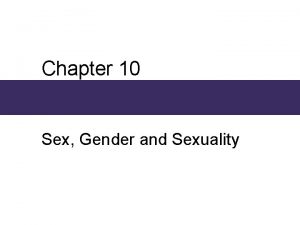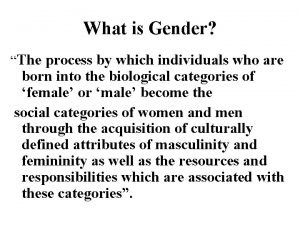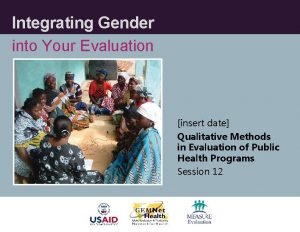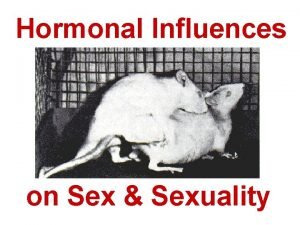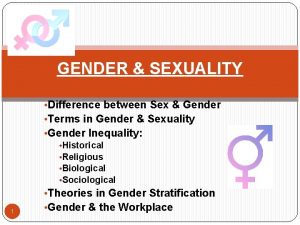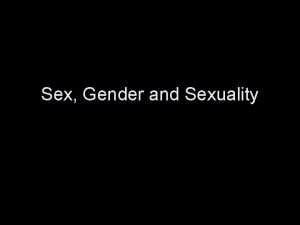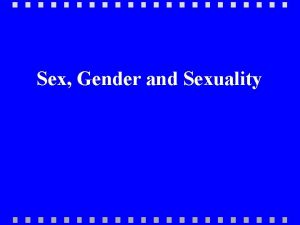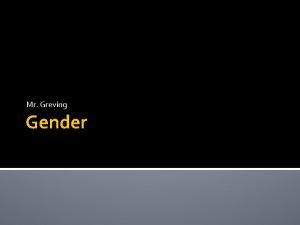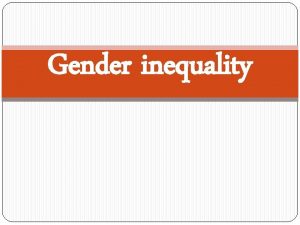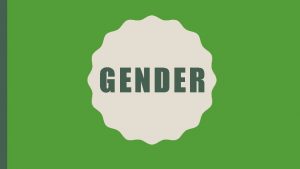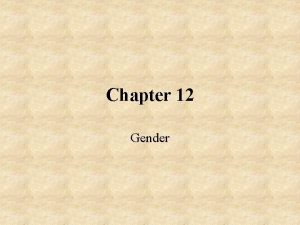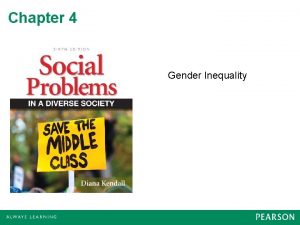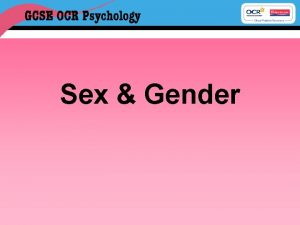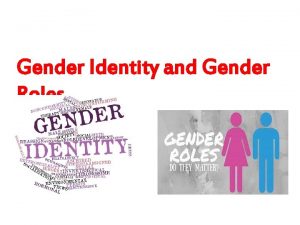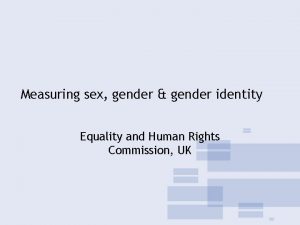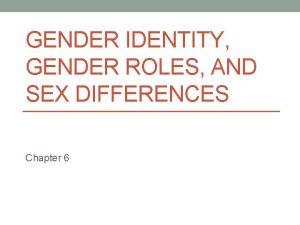Identity and Gender 1 Sex and Gender o














- Slides: 14

Identity and Gender 1

Sex and Gender o Sex n o Gender n o a biological classification. the social attributes associated with being a woman or a man in a particular society. Feminine and masculine n n the qualities particular societies' associate with women and men. ways of differentiating between women and men o o differences are expressed through stereotypical language. Gender identity n n influenced by individual and collective and social and biological factors. Gender identities o often associated with stereotypically feminine and masculine traits. 2

Gender identity and selfcategorization o Self-categorization theory n Tuner et al. o n Althusser o n Identity is shaped by self-categorization. “people are interpellated when they see representation of a category and think yes, that's me". We identify with representations. o Representations connect individuals to groups. 3

Explaining identity: self-categorization theory o o We take on identities appropriate to the social categories with which we identify. Similarities and differences n Influence self-categorization (identity). 4

Gender categories o Anatomical evidence n Biological differences the child is a girl or boy. o o Genetic evidence: n the DNA and sex chromosomes is used to define sex. o o Problem: (Rarely) people have more than two sex chromosomes. Social differences: n n The difference between boys and girls is socially constructed. The birth certificate is based on biological evidence o o Problem: clothes? It counts for getting passport, citizenship, marriage and so on. Social and biological influences are tangled factors contribute to defining sex: n n Dress. Haircut. The genetic information in our cells. The form of our bodies. 5

Are We Free To Change Our Gender Identity? o The UK law: n n o Essentialists: n n o Legal sex: male/female people are not free regardless of bodily evidence. Fixed category: having a Y chromosome is essential to being a male and reduces gender to one factor. All other gender characteristics are consequences of having this essence. Non-essentialists: many factors contribute to the gender categories. n Fuzzy category: To be a man or a woman may vary as time and cultures change 6

Gender stereotypes: o Positive stereotypes: n o Negative stereotypes: n o linked with the in-group. linked with the out-group. People can be more or less typical representatives of the gender categories that they belong to. 7

Summary o Self-categorization theory n o o is an account of identity: interpellation notion. Gender categories are associated with stereotypes. Gender categories show biological, social and genetic factors. 8

Gender Identity And Gender Development: o Children's construction and use of gender categories: n gender-appropriate toys by 2 – 4 years of age. o o n n able to categorize themselves appropriately. early evidence of the formation of the gender identity. They are naively certain about gender. They have a simple in-group and out-group distinction for understanding masculinity and femininity. 9

Gender Identity And Gender Development: o Lack of biological knowledge: n Children look for certainty in gender categories using social and cultural characteristics. 10

Gender Identity And Gender Development: o o Children learn that there are multiple gender identities. Gender categories and gender identities are not fixed: n n Identities are multidimensional. other factors such as ethnicity and social class may reinforce gender and at other times they may outweigh them. o o Thus, there is a diversity of masculinities and femininities. Children's development of understanding gender is a search for certainty. Children make mistakes about gender. As they grow biological knowledge is added to their socialcultural understanding. 11

Gender And Academic Achievement: o People's experience of school differs greatly. n n o Who outperforms the other? n n o o Boys performance Girls performance Male underachievement Female underachievement. What subjects are considered masculine/feminine? Can girls out-achieve boys in “male” subjects? o E. g. , math, science, technology, etc. n 12

The Origins Of Performance Differences o A result of a complex interaction: n n o o Biological factors social-cultural factors Boys and girls have different experiences inside and outside of school. boys : it is "un cool" to be seen as high achievers. 13

Gendered Identities And School Performance o Murphy & Elwood’s Study: n work done in school o Influenced by: different interests, activities and experiences of boys and girls n o lead to differences in examination performance. Examination results n n reflect gendered identities rather than a difference in ability levels between boys and girls. Socio-economic backgrounds: o o Identity and academic achievement is not just an issue of gender; issue of individual differences, social and economic groupings, ethnicity and nationality. 14
 Sex sex sex
Sex sex sex Greenhouse sex
Greenhouse sex Sex sex sex
Sex sex sex Sex sex sex
Sex sex sex Sex sex sex
Sex sex sex Sex linked traits punnett square
Sex linked traits punnett square Sex rat
Sex rat Sex determination and sex linkage
Sex determination and sex linkage Chapter 10 sex gender and sexuality
Chapter 10 sex gender and sexuality Difference between sex and gender
Difference between sex and gender Difference between gender and sex
Difference between gender and sex Androgen insensitivity
Androgen insensitivity Sex and gender difference
Sex and gender difference Difference between sex and gender
Difference between sex and gender Once a sex offender always a sex offender
Once a sex offender always a sex offender








